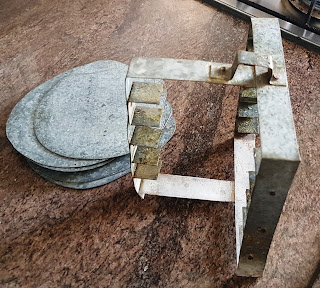- by Deepa Krishnan
The fierce April heat brings with it rashes, skin diseases and the dreaded pox.
.
Before it was eradicated in India, smallpox was one of the most feared diseases of summer. Chicken pox is still a big worry for Indian parents. Many communities believe it is the wrath of the Goddess Mariamman that brings on these diseases, and that she must be propitiated to ward off the pox.
In Mumbai, a small community from Andhra Pradesh worships the Goddess Mariamman every summer, seeking protection from smallpox, chickenpox and all forms of disease. My housemaid is from Andhra Pradesh, so I went with her to see the annual Mariamman ceremony. Mum came along, of course, to find out what it was all about.
The first thing we saw (heard) were the drums. Three men came walking from a little lane, and posed for me.
Then the women emerged from several lanes, carrying offerings for the goddess. Their bowls had a sort of thin gruel, made from ragi and buttermilk, and flavoured with chillies. Ragi, or finger millet came to India 4000 years ago from Ethiopia. It is now a staple part of the local diet.
There were neem leaves in the ragi gruel. Neem has medicinal properties and is used all over the country as a cure for chickenpox.
 Several children and young girls wore skirts of neem, as protection from the pox.
Several children and young girls wore skirts of neem, as protection from the pox.
 A temporary tent had been erected, where everyone gathered with their offerings.
A temporary tent had been erected, where everyone gathered with their offerings.

Inside the tent, there was a little shrine. In the villages of South India, there's a distinctly different looking Mariamman. But this is Bombay! There is no consecrated idol of the goddess here, so a popular representation of Durga was housed inside the tent, with the customary trident.
Mariamman is a proto-Dravidian goddess, not a part of mainstream Vaishnavism or Saivisam. But as usual, both Saivaites and Vaishnavites have appropriated her, because she has such a large following.
.
To get things going, there was a dance. Two male performers had come from a little village in Andhra Pradesh. They were not just dancers, they were more like shamans, intermediaries between the Goddess and the rest. They said a little prayer and tied anklets on their feet.
 The dancing lasted a short while, but it was energetic and graceful.
The dancing lasted a short while, but it was energetic and graceful.

After the dancing, there was a brief prayer ritual. An elder from the community performed the arati. The prayers to Mariamman are "non-agama" i.e. not from the sacred Vedic texts. Brahmins do not conduct prayers to this Goddess, except in a couple of very large Mariamman temples in Tamil Nadu, where the worship has morphed into a fully agamic tradition.
 After the prayer, a desi fowl was offered as sacrifice to please the Goddess and ask her protection.
After the prayer, a desi fowl was offered as sacrifice to please the Goddess and ask her protection.

 This pot would be taken around the city after the sacrifice. It was filled with water, turmeric and neem leaves, and decorated with turmeric, red sindoor, neem, lemon and flowers. In Bombay, this vessel goes to various Tamil and Andhra localities in Dharavi.
This pot would be taken around the city after the sacrifice. It was filled with water, turmeric and neem leaves, and decorated with turmeric, red sindoor, neem, lemon and flowers. In Bombay, this vessel goes to various Tamil and Andhra localities in Dharavi.
 The ragi gruel was then served to everyone as prasadam. It was delicious and cool, by the way. There were a couple of neem leaves in mine, bitter as expected. I ate them, mindful of all the medicinal properties neem has.
The ragi gruel was then served to everyone as prasadam. It was delicious and cool, by the way. There were a couple of neem leaves in mine, bitter as expected. I ate them, mindful of all the medicinal properties neem has.
Customary group photo at the end of the day. This is a section of women from my maid's community. They are Yadavas, a Kshatriya caste who are traditionally cowherds and shepherds. My maid Vasantha is on the extreme left, in an orange saree and red blouse.
(Modified version published in the Hindustan Times HT Cafe City Beat page May 10 2008)




























